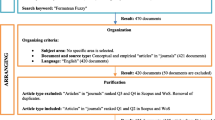Abstract
The paper presents some results obtained in searching for a new axiomatic foundation for partial comparability (PC) in the frame of non-conventional preference modeling. The basic idea is to define an extended preference structure able to represent lack of information, uncertainty, ambiguity, multidimensional and conflicting preferences, using formal logic as the basic formalism.
A four-valued paraconsistent logic is therefore described in the paper as a more suitable language for the purposes of the research. The concepts of partition, general binary relations properties, fundamental relational system of preferences (f.r.s.p.), maximal f.r.s.p. and well founded f.r.s.p. are then introduced and some theorems are demonstrated in order to provide the axiomatic foundation of PC. The main result obtained is a preference structure that is a maximal well founded f.r.s.p. This preference structure facilitates a more flexible, reliable and robust preference modeling. Moreover it can be viewed as a generalization of the conventional approach, so that all the results obtained until now can be used under it.
Two examples are provided at the end of the paper in order to give an account of the operational potentialities of the new theory, mainly in the area of multicriteria decision aid and social choice theory. Further research directions conclude the paper.
Similar content being viewed by others
References
Belnap, N.D.: 1976, ‘How a computer should think’,Proceedings of the Oxford International Symposium on Contemporary Aspects of Philosophy, Oxford, England, pp. 30–56.
Belnap, N.D.: 1977, ‘A useful four-valued logic’, in G. Epstein and J. Dumm, (Eds.),Modern Uses of Multiple Valued Logics, D. Reidel, Dordrecht, pp. 8–37.
Doherty, P., Driankov, D., and Tsoukiàs A.: 1993, ‘Partiality, para-consistency and preference modeling’, submitted (preliminary version inIDA research report Lith-IDA-R-92-18, Linköping University).
Dubarle, D.: 1963, Essai sur la généralisation naturelle de la logique usuelle’, manuscript published posthumously inMathématique, Informatique, Sciences Humaines, No. 107, 1989, 17–73.
Fishburn, P.C.: 1991, ‘Nontransitive preferences in decision theory’,Journal of Risk and Uncertainty,4, 113–134.
Fitting, M.C.: 1990, ‘Bilattices in logic programming’, in G. Epstein (Ed.),Twentieth International Symposium on Multiple-Valued Logic, IEEE, pp. 238–246.
Ginsberg, M.: 1988, ‘Multivalued logics: A uniform approach to reasoning in artificial intelligence’,Computational Intelligence,4, 265–316.
Kacprzyk, J. and Roubens, M. (eds.): 1988,Non Conventional Preference Relations in Decision Making, Springer Verlag, LNMES No. 301, Berlin.
Luce, R.D.: 1956, ‘Semiorders and a theory of utility discrimination’,Econometrica,24, 178–191.
Ovchinnikov, S. and Roubens, M.: 1991, ‘On strict preference relations’,Fuzzy Sets and Systems,43, 319–326.
Ovchinnikov, S. and Roubens M.: 1992, On fuzzy strict preference, indifference and incomparability relations’,Fuzzy Sets and Systems,47, 313–318.
Perny, P. and Roy, B.: 1991, ‘The use of fuzzy outranking relations in preference modeling’,Fuzzy Sets and Systems,49, 33–53.
Roubens, M. and Vincke, Ph.: 1985,Preference Modelling, Springer Verlag, Berlin.
Roy, B.: 1977, ‘Partial preference analysis and decision aid: The fuzzy outranking relation concept’, in D.E. Bell, R.L. Keeney, and H. Raiffa (Eds.),Conflicting Objectives in Decisions, J. Wiley, New York, pp. 40–75.
Roy, B.: 1985,Méthodologie multicritère d'aide à la décision, Economica, Paris.
Roy, B. and Vincke, Ph.: 1984, ‘Relational systems of preferences with one or more pseudo-criteria: some new concepts and results’,Management Science,30, 1323–1335.
Scott, D.: 1982, ‘Some ordered sets in computer science’, in I. Rival (Ed.),Ordered Sets, D. Reidel, Dordrecht, pp. 677–718.
Tsoukiàs, A. and Vincke, Ph.: 1992, ‘A survey on nonconventional preference modelling’,Ricerca Operativa,61, 5–49.
Tsoukiàs A. and Vincke, Ph.: 1994, ‘Extended preference structures in MCDA’, presented atXI International Conference on MCDM, Coimbra, to appear in the proceedings (preprint of SMG).
Tversky, A.: 1969, ‘Intransitivity of preferences’,Psychological Review,76, 31–48.
Author information
Authors and Affiliations
Additional information
This research has been done while the first author was in the Université Libre de Bruxelles under the ‘Research in Brussels actions’.
Rights and permissions
About this article
Cite this article
Tsoukiàs, A., Vincke, P. A new axiomatic foundation of partial comparability. Theor Decis 39, 79–114 (1995). https://doi.org/10.1007/BF01078870
Issue Date:
DOI: https://doi.org/10.1007/BF01078870




